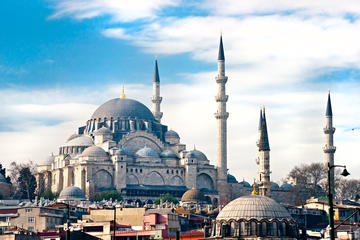Suleymaniye Mosque
TIME : 2016/2/22 16:37:08

Suleymaniye Mosque
The largest mosque in Istanbul, the Suleymaniye Mosque was built between 1550 and 1558 on the orders of Sultan Suleyman the Magnificent. It is widely known as imperial architect Sinan’s greatest masterpiece.
You will enter the mosque through an impressive courtyard featuring columns of marble, granite and porphyry and four corner minarets – a number only allowable for a mosque commissioned by a sultan. Constructed as an almost perfect square, the interior of the Suleymaniye Mosque is grand in its simplicity, with basic designs in ivory and mother of pearl and a subtle use of Iznik tiles.
The mosque was designed as part of a larger complex that included a hospital, primary school, a caravanseri, four madrassahs, a medical college and a public kitchen. Two mausoleums stand in the gardens behind the mosque, including the tombs of Suleyman I and his wife, daughter, mother and sister, as well as several other Ottoman sultans.
A fire ravaged the mosque in the 17th century, but it was later restored by Sultan Mehmed IV. An earthquake in 1766 caused part of the dome to collapse and later restorations damaged much of the original decorations inside the mosque. A full restoration was finally completed in the 1950s and further restoration work was completed in 2010.
Practical Information
The Suleymaniye Mosque is located in the Fatih district in Istanbul, not far from Istanbul University. Traveling by bus or tram, you will likely need to navigate through Istanbul’s winding streets to reach the mosque; the most direct route may be to take the tram to the Laleli-Universitet stop. Walk along Ordu Caddesi to Fethi Bey Caddesi, take a left and follow Fethi Bey Caddesi as it turns into Suleymaniye Caddesi. The mosque should soon come into view. It is open daily and admission is free, but if you are not Muslim, you should avoid visiting within thirty minutes after the call to prayer. Dress modestly and remove your shoes before entering.
